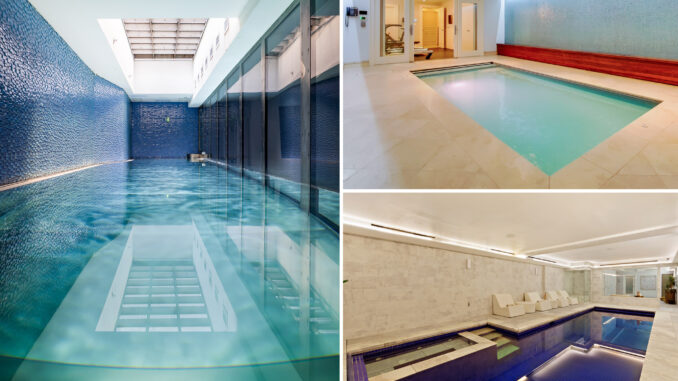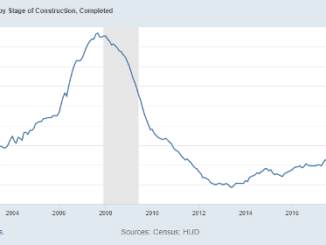
Even for the fabulously wealthy in New York, a private basement lap pool is a rare amenity.
How many Manhattan townhouses come with such a splashy hangout? Possibly a few dozen. Four are currently on the market.
These four historic homes, all dating from the 19th century, have been redone with lavish interiors, landscaped patios and the pièce de résistance: a natatorium.
All of the pool-enhanced homes, not coincidentally, are being sold by hedge-fund, private-equity or investing heavyweights.
For the rest of us, as summer comes to a close, Manhattan has more than a dozen free public outdoor pools, open through Sept. 10. Expect crowds, not privacy. The Parks Department website notes that “there is often a line to enter our pools. We promise, it’s worth the wait!”
There’s no wait, however, for the buyer of the 25-foot-wide Greek Revival mansion at 109 Waverly Place in Greenwich Village, which has been sporadically on the market for around six years. It’s asking $21.95 million.
The residence has the luxuries one would expect in such a home — an elevator, a wood-burning fireplace, a hookup for a second washer/dryer — and a gym and sauna adjacent to an “enchanting, glass-enclosed, skylit lap pool.”
At 109 Waverly Place, the pool comes enclosed in glass.
Even outside, friends and family can watch people swim indoors.
For sunbathing, 109 Waverly has room for that — and with views, to boot.
The pool itself has a noteworthy design, says the listing agent, Rachel Glazer of Compass. “You can see people swimming — it’s like you’re looking into a fishbowl,” she said. Currently, rental tenants are in place, “paying six figures a month.”
On the Upper West Side, 45 W. 70th St. is listed by Anne Prosser of Brown Harris Stevens. That one is $14.9 million, down from $17.5 million two years ago.
The pool was added about 10 years ago, says Sandra Piedrabuena, who is selling the house with her husband, Russell Abrams. They considered a resistance pool — the swimming equivalent of a treadmill — but decided to go with a bigger lap pool instead.
The exterior of 109 Waverly, listed for $21.95 million.
In other areas inside, the home also dazzles with high design.
The family planned to remain in the city, but COVID-19 disrupted their lives. They have since moved to Miami.
“It was tough construction,” Piedrabuena said of the 33-foot-long pool. “It is a big job, and brings dust and noise.”
But it also made for sweet memories. The family’s three school-age children learned to swim in the pool. The family would host parties and “we would invite every person — kids, neighbors, classmates,” Piedrabuena said.
“I think the house has to bring a buyer who loves to swim or is very interested in having a pool,” she said. “It is not a hassle to maintain and it brings a lot of joy to the family.”
45 W. 70th St. has its own pool that was installed about 10 years ago — and the family who had it enjoyed many happy memories with it in their home.
The West 70th Street residence asks $14.9 million for sale.
Farther uptown is 45 W. 95th St. for $10 million, listed by Amanda Conte of Compass.
Prospective buyers are attracted by the 25-foot-long pool, she says. A home gym is adjacent to the pool room, as is a mechanical room with its dehumidification system.
Influenced by COVID, “people want more space and more things to do in their home,” she said. “The pool is a bonus when they have young children” — and is good not just for fun, but also for exercise and physical therapy.
In Lenox Hill, the neo-Roman townhouse at 45 E. 74th St. is for sale for $26.5 million, also with a small gym and a steam sauna. For sunbathing, there’s a rooftop terrace, with an elevator to smooth the ascent.
Beyond the perk of an indoor pool, the townhouse has great al-fresco amenities, such as room for outdoor entertaining.
The property additionally includes a lovely terrace space.
Other indoor areas of the home are also stylish.
Maintenance for such pools tends to be easy, pool experts say. Indoor pools require little more than cleaning, and don’t collect leaves or debris as their outdoor counterparts.
But they bring other maintenance considerations. Pool experts note that wood, sheetrock or carpets — anything that can absorb moisture — can be damaged. So dehumidification is essential — with a dehumidification system located in a nearby mechanical room, if not in a yard or on a roof.
Private pools are most often situated in terraces or penthouses in new construction, says David Plotkin, president of Steelways, Inc., of Newburgh, which fabricates steel pools along with bridges, tanks, caissons and barges, and is located in a shipyard along the Hudson River.
“It’s rare that a swimming pool goes into an existing building,” he said. “For a basement pool, you can do concrete or steel. Concrete is cheaper.” But when a pool is higher up, “you need structural steel support” to hold the water’s enormous weight.
A view of the pool at 45 W. 95th St., listed for $10 million.
Unsurprisingly, the 45 W. 95th St. home has other great features included in the sale, such as this massive kitchen.
At least the prospective buyers of these four listed homes, or those in the vicinity, wouldn’t need to deal with the headache of an installation.
The city’s Department of Buildings has no count of basement pools, which don’t require separate permits. But at least two pools were added in existing rowhouses in the last few years, says a spokesman — one each on the Upper East and Upper West Sides.
There is also the notorious 48-50 W. 69th St. pool, where neighbors were plagued by noise, vibration, dust and fumes from the excavation for a 60-foot-long pool and other subterranean spaces.
The owners, who combined two side-by-side townhouses, dug 38 feet down into the famously hard bedrock known as Manhattan schist. Permits for the project, which could cost an estimated $100 million, were issued six years ago and remain active. The DOB website lists almost 50 complaints.
Basement or cellar pools in Manhattan are “very difficult to build,” said architect Bill Simmons of Aquatechtonic, the pool division of Lothrop Associates Architects in White Plains. The logistics are daunting, involving narrow workspaces and little room to maneuver.
The property stands on a leafy block.
On a small city worksite on a one-way street, “you can’t back up a concrete truck,” Simmons said.
In a Manhattan rowhouse, “you’ve got to do a lot of hand digging with small equipment — wheelbarrows and shovels — which is obviously very labor intensive,” he said.
Situating a pool in rock is good for the pool, he said. “It won’t crack or shift.” But it’s bad for the neighbors who must suffer through the construction. “Removing rock not only makes you a lot of enemies but also costs you a lot of money, though cost doesn’t seem to be an issue for these projects,” Simmons said.
There are, however, many complex design considerations. “You have a very big warm bath sitting down in the basement all the time,” Simmons said. “You require all this compartmentalization around the pool.” The piping should be accessible so it can be maintained or inspected. “It can all be managed but it requires architects to know what they are doing.”
Simmons has also seen such projects abandoned. People sometimes decide “this is way more project than they can be involved with,” he said.
“What surprises me is that people are making these really fancy spaces that are not going to get used that much. How much time are you going to spend in a bathing suit in the cellar?”
Real Estate – Latest NYC, US & Celebrity News



